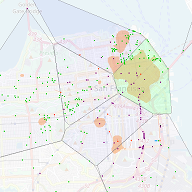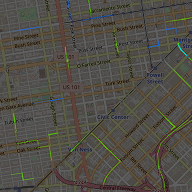Autonomous mobility-on-demand simulation library, version 2.1.1
AMoDeus is jointly maintained and further developed by the Admins Christian Fluri (ETH Zürich), Joel Gächter (ETH Zürich), Sebastian Hörl (IRT SystemX), Claudio Ruch, Jan Hakenberg, ChengQi Lu (TU Berlin), and Marc Albert (nuTonomy). There is a Slack channel where stakeholders of the library meet and exchange.
Please let us know if you'd like to contribute to the code or join the Slack channel!
This repository is a library that allows the simulation of autonomous mobility-on-demand (AMoD) system including their fleet management algorithms in the multi-agent transportation simulation environment MATSim.
Try it, orchestrate your own fleet of amod-taxis! To get started, install and run amod. Here is a visualization.
Our website is amodeus.science.
The code manages the dispatching of autonomous taxis in the MATSim environment. It provides standard autonomous mobility-on-demand dispatching algorithms and an API to implement and test novel ones.
- Adaptive Real-Time Rebalancing Policy from Robotic load balancing for mobility-on-demand systems by Pavone, M., Smith, S.L., Frazzoli, E. and Rus, D., 2012.
- Feedforward Fluidic Optimal Rebalancing Policy from Robotic load balancing for mobility-on-demand systems by Pavone, M., Smith, S.L., Frazzoli, E. and Rus, D., 2012.
- Global Bipartite Matching Policy fromRuch, Claudio, Sebastian Hörl, and Emilio Frazzoli. "Amodeus, a simulation-based testbed for autonomous mobility-on-demand systems." 2018 21st International Conference on Intelligent Transportation Systems (ITSC). IEEE, 2018.
- SQM algorithm from Fundamental Performance Limits and Efficient Polices for Transportation-On-Demand Systems by M.Pavone, K.Treleaven, E.Frazzoli, 2010.
- Demand-supply-balancing dispatching heuristic from Large-scale microscopic simulation of taxi services by Maciejewski, M., and Bischoff J., 2015.
- First Come First Served Strategy with Grid Rebalancing from Operations of Shared Autonomous Vehicle Fleet for Austin, Texas, Market by Fagnant, D. J., Kockelman, K. M., and Bansal, P., 2015.
- Feedforward time-varying rebalancing policy from Spieser, Kevin, Samitha Samaranayake, and Emilio Frazzoli. "Vehicle routing for shared-mobility systems with time-varying demand." American Control Conference (ACC), 2016. IEEE, 2016.
- +1 method from The +1 Method: Model-Free Adaptive Repositioning Policies for Robotic Multi-Agent Systems by Ruch, C., Gächter, J., Hakenberg, J. and Frazzoli, E., 2019.
- DFR algorithm from Albert, M., Ruch, C. and Frazzoli, E. "Imbalance in Mobility-on-Demand Systems: A Stochastic Model and Distributed Control Approach." ACM Transactions on Spatial Algorithms and Systems (TSAS) - Special Issue on Urban Mobility: Algorithms and Systems, 2019.
- Control policy requiring no explicit communication and sensor based control policy from Arsie, Alessandro, Ketan Savla, and Emilio Frazzoli. "Efficient routing algorithms for multiple vehicles with no explicit communications." IEEE Transactions on Automatic Control, 2009.
- Demand-supply-balancing with Beam Extension for Ride Sharing Demand Supply Balancing heuristic from Large-scale microscopic simulation of taxi services by Maciejewski, M., and Bischoff J., 2015 extended with ride sharing if two requests start close to each other and have a similar direction.
- Dynamic Ride Sharing Strategy from Dynamic ride-sharing and optimal fleet sizing for a system of shared autonomous vehicles by Fagnant, D. J., and Kockelman, K. M., 2015.
- T-Share from Ma, Shuo, Yu Zheng, and Ouri Wolfson. "T-share: A large-scale dynamic taxi ridesharing service." Data Engineering (ICDE), 2013 IEEE 29th International Conference on. IEEE, 2013.
- High-Capacity Algorithm from Alonso-Mora, Javier, et al. "On-demand high-capacity ride-sharing via dynamic trip-vehicle assignment." Proceedings of the National Academy of Sciences 114.3 (2017): 462-467.
Specify repository and dependency of the amodeus library in the pom.xml file of your maven project:
<repositories>
<repository>
<id>amodeus-mvn-repo</id>
<url>https://raw.github.com/amodeus-science/amodeus/mvn-repo/</url>
<snapshots>
<enabled>true</enabled>
<updatePolicy>always</updatePolicy>
</snapshots>
</repository>
</repositories>
<dependencies>
<dependency>
<groupId>amodeus</groupId>
<artifactId>amodeus</artifactId>
<version>2.1.1</version>
</dependency>
</dependencies>The source code is attached to every release.
AMoDeus was originally introduced in the paper
- AMoDeus, a simulation- based testbed for autonomous mobility-on-demand systems by Ruch, C., Hörl, S., Frazzoli, E., in 21st International Conference on Intelligent Transportation Systems (ITSC), pages 3639–3644, 2018.
Since then, the library has been used for various scientific contributions, including:
- Quantifying the efficiency of ride sharing by Ruch, C., Lu, C., Sieber, L., and Frazzoli, in IEEE Transactions on Intelligent Transportation Systems, 10.1109/TITS.2020.2990202, 2020
- Improved public transportation in rural areas with self-driving cars: A study on the operation of Swiss train lines. by Sieber, L., Ruch, C., Hörl, S., Axhausen, K.W., and Frazzoli, E. in Transportation Research Part A: Policy and Practice, 134:35–51, 2020
- Fleet operational policies for automated mobility: A simulation assessment for Zurich by Hörl, S., Ruch, C., Becker, F., Frazzoli, E., and Axhausen, K, in Transportation Research Part C: Emerging Technologies, 102:20–31, 2019
- Learning to operate a fleet of cars by Fluri, C., Ruch, C. Zilly, J., and Frazzoli, E., . In 2019 IEEE Intelligent Transportation Systems Conference (ITSC), pages 2292–2298. IEEE, 2019
- Imbalance in mobility-on-demand systems: A stochastic model and distributed control approach by Albert, M., Ruch, C., and Frazzoli, E. in ACM Transactions on Spatial Algorithms and Systems (TSAS), 5(2):13, 2019
- Scalable model predictive control for autonomous mobility-on-demand systems by Carron, A., Seccamonte, F., Ruch, C., Frazzoli, E., and Zeilinger, M., in IEEE Transactions on Control Systems Technology, pages 1–10, 2019
- The value of coordination in one-way mobility-on-demand systems by Ruch, C., Richards, S., and Frazzoli, in IEEE Transactions on Network Science and Engineering, 10.1109/TNSE.2019.2912078, 2019
So beherrscht mein äusserer Sinn die physische, mein innerer Sinn die moralische Welt. Alles unterwirft sich meiner Willkür, jede Erscheinung, jede Handlung kann ich nennen, wie es mir gefällt; die lebendige und leblose Welt hängt an den Ketten, die mein Geist regiert, mein ganzes Leben ist nur ein Traum, dessen mancherlei Gestalten sich nach meinem Willen formen. Ich selbst bin das einzige Gesetz in der ganzen Natur, diesem Gesetz gehorcht alles.






